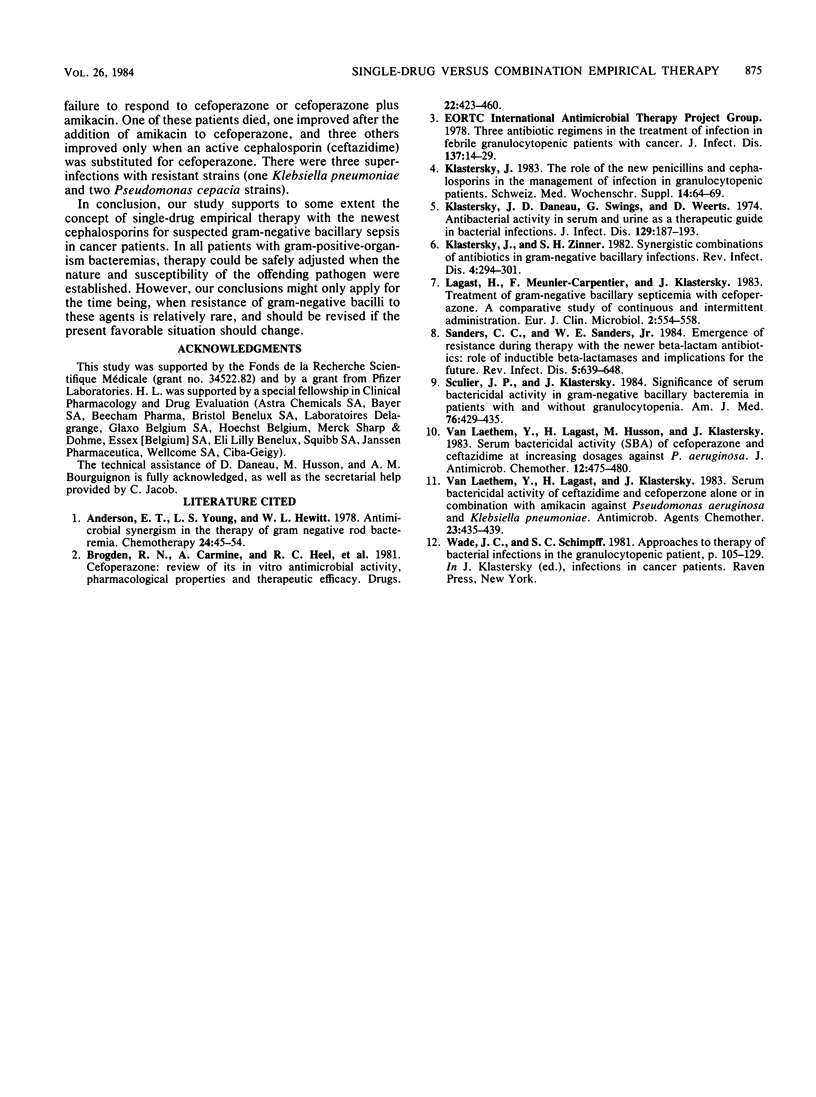Abstract
Empirical therapy with cefoperazone was compared with cefoperazone plus amikacin in granulocytopenic and nongranulocytopenic febrile patients. In nonneutropenic patients the overall response rate to cefoperazone was 88%; 10 of 12 gram-negative bacteremic patients were cured. Cefoperazone plus amikacin resulted in an 88% overall response rate and cured 14 of 15 patients with bacteremia. In neutropenic patients the overall response rate was 77% with cefoperazone alone and 73% with cefoperazone plus amikacin; the cure rates for gram-negative bacteremias were 8 of 11 and 6 of 12 patients, respectively. Our findings support the concept of single-drug empirical therapy with cefoperazone in febrile cancer patients, whether granulocytopenic or not, especially when gram-negative bacteremias are predominantly caused by Escherichia coli or Klebsiella species. The issue of Pseudomonas spp. and other more resistant pathogens needs further assessment with a larger number of patients.
Full text
PDF





Selected References
These references are in PubMed. This may not be the complete list of references from this article.
- Anderson E. T., Young L. S., Hewitt W. L. Antimicrobial synergism in the therapy of gram-negative rod bacteremia. Chemotherapy. 1978;24(1):45–54. doi: 10.1159/000237759. [DOI] [PubMed] [Google Scholar]
- Brogden R. N., Carmine A., Heel R. C., Morley P. A., Speight T. M., Avery G. S. Cefoperazone: A review of its in vitro antimicrobial activity, pharmacological properties and therapeutic efficacy. Drugs. 1981 Dec;22(6):423–460. doi: 10.2165/00003495-198122060-00002. [DOI] [PubMed] [Google Scholar]
- Klastersky J., Daneau D., Swings G., Weerts D. Antibacterial activity in serum and urine as a therapeutic guide in bacterial infections. J Infect Dis. 1974 Feb;129(2):187–193. doi: 10.1093/infdis/129.2.187. [DOI] [PubMed] [Google Scholar]
- Klastersky J. The role of the new penicillins and cephalosporins in the management of infection in granulocytopenic patients. Schweiz Med Wochenschr Suppl. 1983;14:64–69. [PubMed] [Google Scholar]
- Klastersky J., Zinner S. H. Synergistic combinations of antibiotics in gram-negative bacillary infections. Rev Infect Dis. 1982 Mar-Apr;4(2):294–301. doi: 10.1093/clinids/4.2.294. [DOI] [PubMed] [Google Scholar]
- Lagast H., Meunier-Carpentier F., Klastersky J. Treatment of gram-negative bacillary septicemia with cefoperazone. Eur J Clin Microbiol. 1983 Dec;2(6):554–558. doi: 10.1007/BF02016564. [DOI] [PubMed] [Google Scholar]
- Sanders C. C., Sanders W. E., Jr Emergence of resistance during therapy with the newer beta-lactam antibiotics: role of inducible beta-lactamases and implications for the future. Rev Infect Dis. 1983 Jul-Aug;5(4):639–648. doi: 10.1093/clinids/5.4.639. [DOI] [PubMed] [Google Scholar]
- Sculier J. P., Klastersky J. Significance of serum bactericidal activity in gram-negative bacillary bacteremia in patients with and without granulocytopenia. Am J Med. 1984 Mar;76(3):429–435. doi: 10.1016/0002-9343(84)90662-4. [DOI] [PubMed] [Google Scholar]
- Van Laethem Y., Lagast H., Husson M., Klastersky J. Serum bactericidal activity of cefoperazone and ceftazidime at increasing dosages against Pseudomonas aeruginosa. J Antimicrob Chemother. 1983 Nov;12(5):475–480. doi: 10.1093/jac/12.5.475. [DOI] [PubMed] [Google Scholar]
- Van Laethem Y., Lagast H., Klastersky J. Serum bactericidal activity of ceftazidime and cefoperazone alone or in combination with amikacin against Pseudomonas aeruginosa and Klebsiella pneumoniae. Antimicrob Agents Chemother. 1983 Mar;23(3):435–439. doi: 10.1128/aac.23.3.435. [DOI] [PMC free article] [PubMed] [Google Scholar]


